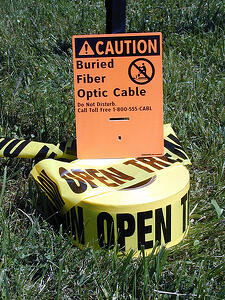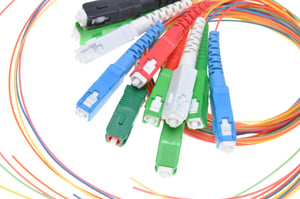
When a company is investigating an upgrade to a fiber-optic network, one of the most basic questions to answer is "which kind of fiber do I need to use?" There are two major kinds of fiber-optic cabling: Single-Mode and Multi-Mode.
While it's not impossible to get the two types to interact with the right transceivers and intermediate hardware, there's significant signal loss involved in the transition and, therefore, much higher power requirements to re-boost it. It's best to simply lay the kind of fiber that best meets your needs.
Today, we'll take a look at Multimode fiber optic cable, and the uses it's put to. Tomorrow, we'll examine Single-Mode in more depth.
What Makes Multi-Mode Fiber Optic Cables Different
The significant difference in Multi-Mode is the size of its "core," the actual glass wire which holds/transmits optical signals. While Single-Mode uses a very thin core, which isolates the laser to a single beam, Multi-Mode allows it to reflect back and forth within the core. Several beams can be sent at once.
This allows Multi-Mode to handle far higher data rates than Single-Mode, because the larger core simply allows more light to pass through at once. More light means more data.
The downside is that because the light is consistently bouncing around inside the core, there are constant interference issues. Multi-Mode fiber has much shorter effective transmission distance before signal degradation starts corrupting the data being sent.
The maximum transmission distance for 10Gb/s Multi-Mode fiber is around six hundred meters. It can transmit farther at lower data rates, such as going about 2km at 100Mb/s.
Typical Uses For Multi-Mode Fiber
1 - A Fiber Backbone
Broadly, the most common application for Multi-Mode fiber cable is to create a backbone for a company's network. If you're looking at 802.11ac or newer WiFi access points, a Multi-Mode fiber backbone is virtually required to get top speeds out of your access points.
2 - High Speed Local Deployments
Some businesses, especially those dealing in very large data sets, are starting to simply roll out Multi-Mode throughout their office. If your employees are regularly sending gigabyte-sized files around, this is currently one of the best options for boosting their transmission speeds.
 Obviously, this is an expensive approach, but at least it's future-proofed. Optical is currently the fastest cabling we have, and it's likely to remain so for years in the future. A local fiber network today would be ready for virtually any speed upgrades you'd install for 5-10 years, at least.
Obviously, this is an expensive approach, but at least it's future-proofed. Optical is currently the fastest cabling we have, and it's likely to remain so for years in the future. A local fiber network today would be ready for virtually any speed upgrades you'd install for 5-10 years, at least.
3 - "Fiber To The Telecom Enclosure" (FTTE)
As a compromise between the two above options, some companies split it down the middle. The fiber connection continues past their server, and goes to a "Telecommunications Enclosure" (TE) which is in a central location, near to the employees connected to it.
It's an affordable way to deliver fiber, almost all the way to the desktop, without the higher expenses of a full wiring job. The main drawback is that your TE is nearly as vulnerable as your server room in terms of security, and would have to be tightly protected from intrusion.
If Your Office Needs Fiber, It Probably Needs Multi-Mode
That's the key takeaway here. As we'll discuss in our follow up post, Single-Mode fiber is more specialized and mostly used for long-distance data transmission. For local wiring, it's likely to be Multi-Mode.
Need more advice on your upgrade options? Hummingbird Networks is one of the west coast's premiere networking consultants, with decades of experience upgrading networks large and small. We'll look at your future plans, and find the network which can make it happen.
Just contact us for a free network assessment.
photo credit: <a href="https://www.flickr.com/photos/smartsignbrooklyn/10275717526/">SmartSignBrooklyn</a> via <a href="http://photopin.com">photopin</a> <a href="http://creativecommons.org/licenses/by/2.0/">cc</a>











